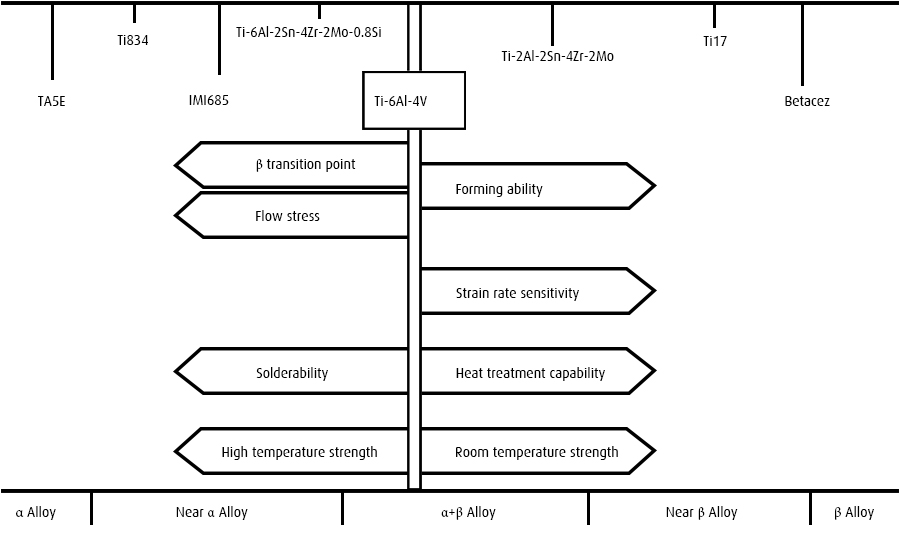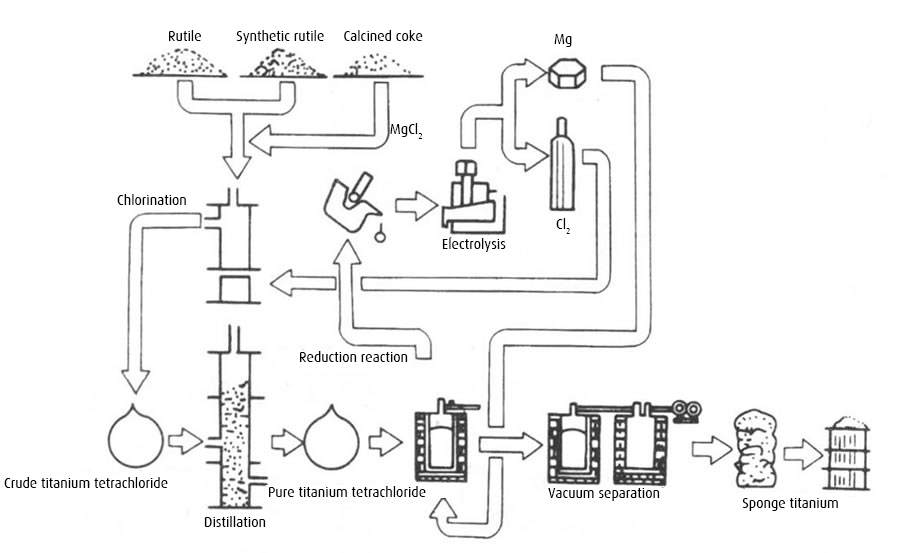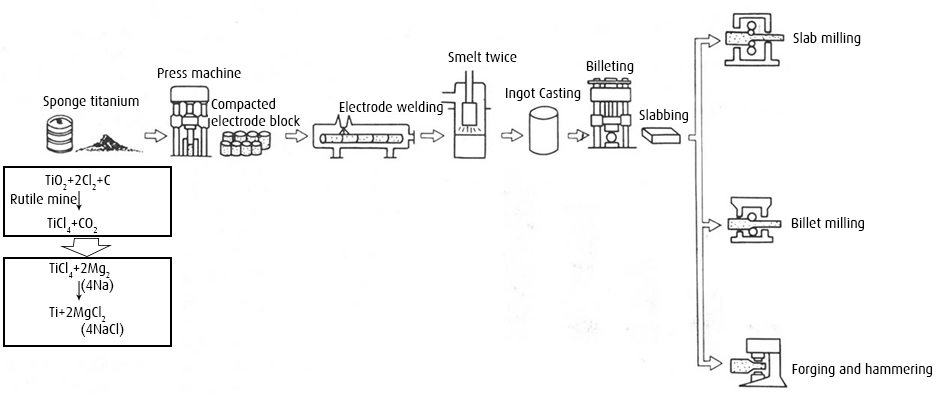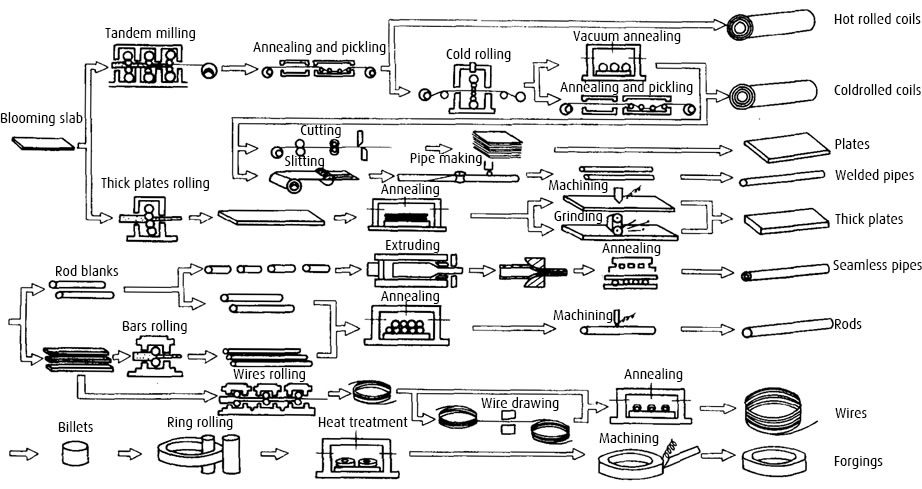Titanium Alloy
Titanium is an important structural metal developed in the 1950s. The first practical titanium alloy was the Ti-6Al-4V alloy successfully developed by the United States in 1954. Due to its heat resistance, strength, plasticity, toughness, Formability, weldability, corrosion resistance, and biocompatibility are all good, and it has become the flagship alloy in the titanium alloy industry, and the amount of this alloy used has accounted for 75% to 85% of all titanium alloys. Many other titanium alloys can be regarded as modifications of Ti-6Al-4V alloy.
Titanium alloys are widely used in various fields because of their high strength, good corrosion resistance, high heat resistance, good low temperature performance, and high chemical activity. In addition, titanium alloys have poor process performance and difficult cutting and processing. In hot processing, it is very easy to absorb impurities such as hydrogen, oxygen, nitrogen, and carbon. There is also poor abrasion resistance and complicated production processes.
Physical properties of Titanium Alloys
| Density (20℃) /g.cm-3 |
Melting point /℃ |
Specific heat capacity (0~100℃) /J. kg-1K-1 | |
| Ti-4Al-0.005B | 4.43 | 523 | |
| Ti-5Al-2.5Sn | 4.42 | 1540~1650 | 503 |
| Ti-3Al-2.5V Grade9 | 4.47 | 1700~1726 | 858 |
| Ti-15V-3Cr-3Sn-3Al | 4.77 | 536 | |
| Ti-6Al-4V Grade5 | 4.44 | 1630~1650 | 611 |
| Linear expansion coefficient (20~100℃)/10-6K-1 | Resistivity(20℃)/μΩ.cm | ||
| Ti-4Al-0.005B | 9.28 | 1.26 | |
| Ti-5Al-2.5Sn | 8.5 | 1.38 | |
| Ti-3Al-2.5V Grade9 | 8.77 | 1.25 | |
| Ti-15V-3Cr-3Sn-3Al | 8.81 | 1.45 | |
| Ti-6Al-4V Grade5 | 9.1 | 1.7 |
Classification of Titanium Alloys
According to the method of classification according to the annealed phase composition, titanium alloys are divided into α-type, α+β-type and β-type titanium alloys.
The main characteristics of various titanium alloys are as follows. The figure is based on Ti6-Al-4V, to the right, with the increase of β-stabilizing elements. The alloy’s formability, strain rate sensitivity, heat treatment strengthening effect, and room temperature strength are continuously improved; to the left, the alloy’s beta transition temperature, flow stress, weldability, and high temperature strength increase with decreasing beta stabilizing elements.

List the relative positions of some titanium alloys in the phase diagram. The overall strength distribution level (annealed state and solution aging state) and microstructure of each alloy in the whole phase diagram are shown. Alloys near the critical composition Ckp have the finest and most uniform microstructures and the highest strength grades. Composition and microstructure play a decisive role in the properties of titanium alloys. The research on the composition-structure-property of titanium alloys has gradually changed from qualitative analysis to quantitative process.

Choices of Titanium Alloy
Production and process flow of titanium and titanium alloys
The main technological processes of titanium and titanium alloys are the preparation of sponge titanium, the smelting of titanium ingots and the processing of titanium materials.
Titanium sponge is obtained from rutile ore (TiO2) by chlorination to form TiCl4 and then reducing TiCl4 with Mg.

The smelting of titanium ingots and the processing of titanium materials are relatively complex, mainly including the crushing and refining of sponge titanium and the pressing and welding of electrodes, and then the vacuum consumable electrode method is used to smelt several times to form titanium ingots, and then forging and billeting, hot rolling and welding. Cold rolled and finally vacuum annealed for coil supply. The production process of titanium alloy semi-finished products is shown in the figure.


Classification and characteristics of Titanium and Titanium Alloys
| Classification | Composition characteristics | Microstructure characteristics | Performance characteristics | Typical alloy | |
| α Type Titanium Alloy | α Alloy | Contain less than 6% aluminum and a small amount of neutral elements | After annealing, except for a small amount of β phase caused by impurity elements, almost all of it is α phase | Low density, good thermal strength, good welding performance, low gap element content and good super Low temperature toughness | TA0~TA7 TA9 |
| Near α Alloy | In addition to aluminum and neutral elements, there are a small amount (not more than 4%) of β-stabilizing elements | After annealing, in addition to a large amount of α phase, there is also a small amount (about 10% by volume) of β phase. | Can be strengthened by heat treatment, has good thermal strength and thermal stability, and good welding performance | ||
| α+ Compound Alloy | Add a small amount of active co-folding elements on the basis of all α alloys | After annealing, in addition to a large amount of α phase, there are also a small amount of β phase and intermetallic compounds. | It has a precipitation hardening effect, improves the tensile strength and creep strength at room temperature and high temperature, and has good weldability | TA8 and Ti-2.5Cu | |
| α+β Type Titanium Alloy | Contains a certain amount of aluminum (less than 6%) and different amounts of beta stable elements and neutral elements | After annealing, there are different proportions of α and β phases | Can be heat treated to strengthen, strength and hardenability, with the increase of β-stabilizing element content High, good weldability, generally cold forming and Poor cold working ability, TC4 alloy has good ultra-low temperature toughness at low interstitial element content | TC1~ TC10 | |
| β Type Titanium Alloy | Thermally Stable β Alloy | Contains a lot of β-stabilizing elements and sometimes a small amount of other elements | After annealing, all are β phase | Low room temperature strength, strong cold forming and cold working ability, good corrosion resistance in reducing media, but good stability and weldability | Ti-32Mo |
| Metastable β Alloy | Contains beta stable elements above the critical concentration, a small amount of aluminum (generally not more than 3%) and neutral elements | After solid solution treatment (water quenching or air cooling) from the β phase region, almost all of them are metastable β phase. The structure after aging at increased temperature is α phase, β phase, and sometimes a small amount of compound phase | After solution treatment, the room temperature strength is low, the cold forming and cold working ability is strong, and the weldability is good. After aging, the room temperature strength is high. In Gaoqu It has high fracture toughness under service strength and poor thermal stability above 350℃. This kind of alloy has good hardenability | TB1、TB2 | |
| Near β Alloy | Contains beta stable elements with a critical concentration, and a certain amount of neutral elements and aluminum | After solid solution treatment in the β phase region, there are a large amount of metastable β phase, and there may be a small amount of other metastable phases (α' or ω phase). After aging, mainly α phase and β phase, in addition, metastable β phase can be strained change | In addition to the characteristics of metastable beta alloys, after solution treatment, the yield strength is low, the uniform elongation is high, and after aging, the fracture toughness and forging plasticity are higher | Ti-10V-2Fe-3Al | |
Application of Titanium and Titanium Alloys
| Application field | Use characteristics of materials | Application | ||
| Aircraft Industry | Jet Engine | Below 500℃, with high yield strength/density ratio and fatigue strength/density ratio, good thermal stability, excellent resistance to atmospheric corrosion, and can reduce weight. | Used in parts below 500°C: compressor plate; stationary blades, moving blades, casing, combustion chamber casing, exhaust mechanism casing, central body, jet pipe, etc. | |
| Body of Aircraft | Below 300℃: high specific strength | Fire walls, skins, girders, landing gear, wing ribs, bulkheads, fasteners, ducts, hatches, tie rods, etc. | ||
| Rocket, Missile and Spacecraft Industry | At room temperature and ultra-low temperature, the specific strength is high, and it has sufficient toughness and plasticity | High pressure vessel, fuel tank, rocket engine and missile shell, spacecraft rudder skin and structural skeleton, main landing gear, lunar module, etc. | ||
| Shipbuilding Industry | High specific strength, excellent corrosion resistance in sea water and ocean atmosphere | Pressure hull, structural parts, buoyancy system sphere, pump body of watercraft, pipe and deck accessories, speedboat propeller, propulsion shaft, hydrofoil hydrofoil, whip antenna, etc. | ||
| Chemical Industry | It has good corrosion resistance in oxidizing and neutral media, and can also improve its corrosion resistance through alloying in reducing media | In petrochemical, fiber, pulp, fertilizer, acid and alkali, sodium, alkali, chlorine, electrochemistry and seawater desalination industries, it is used as heat exchanger, reaction tower, distiller, washing tower, synthesizer, autoclave, valve, etc. Conduit, pump, pipe, electrolysis electrode, electrolysis cell, anode frame, spinneret, etc. | ||
| Other Industry | Conventional Weapons Manufacturing | Good corrosion resistance and low density | Artillery tailstock, mortar floor, rocket gun barrel and chamber, nozzle, artillery hoop, tank wheel, track, torsion bar, tank drive shaft, armor plate, etc. | |
| Metallurgical Industry | High chemical activity and good corrosion resistance | Used as corrosion-resistant material in the smelting of non-ferrous metals such as nickel, cobalt, titanium, etc., it is a good deoxidizer and alloy element in steel smelting | ||
| Medical Hygiene | It has excellent corrosion resistance to human body fluids, is non-toxic, and has good affinity with muscle tissue | To make medical equipment and surgical orthopedic materials, titanium teeth, heart valves, diaphragms, bone joints and fixation screws, titanium bones, etc. | ||
| Ultra-high Vacuum | With high chemical activity, it can adsorb oxygen, nitrogen, hydrogen, CO, CO2, methane and other gases | Titanium ion pump | ||

 +86 13120915623
+86 13120915623